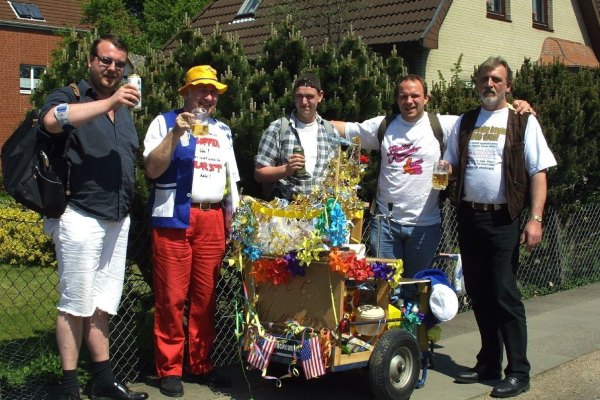Father’s Day is celebrated differently in each country, influenced by culture and history. It is a day to honor fathers, their bonds with their kids, and their roles in families and society. Well, this day is celebrated on different dates depending on the country.
Lots of countries celebrate Father’s Day on the third Sunday of June. But some countries like Spain and Portugal, celebrate on March 19th, which is also the day they honor St. Joseph, who is traditionally regarded as the fatherly figure in the Christian religion.
In this article, we will find out how people in different cultures celebrate Father’s Day around the world alongside exploring various rituals and fun ways people celebrate this special day.
Exploring the Origins: The History of Father’s Day Celebrations
Like Mother’s Day, Father’s Day has its origins in the United States. It began in 1909 when Sonora Smart Dodd from Spokane, Washington, honored her father, William Jackson, who raised 14 kids on his own. William is a Civil War veteran and single parent who raised six children on his own after his wife passed away during childbirth.

Dodd wanted to celebrate it on June 5th, her dad’s birthday. But due to a lack of time to prepare, the first Father’s Day was celebrated on June 19th, 1910. Since then, it has been celebrated every year on the third Sunday of June. It is celebrated worldwide but each place has its date and way of celebrating. Ultimately, it is all about showing love and respect to dads and other important male figures for all they do for families and communities.
Let’s explore how different countries celebrate Father’s Day and how fascinating traditions vary from one place to another.
United States
In the US, Father’s Day is celebrated on the third Sunday of June, the same date as UK and Canada. It is a joyful day when children give cards and gifts to their fathers. Families come together, especially kids who don’t live at home, to celebrate with their dad. It is a tradition to spoil a father with breakfast in bed and gifts like cards, flowers, chocolates, and ties.
Mexico
In Mexico, Father’s Day, also known as “Dia del Padre” is celebrated on the third Sunday of June. Families come together for meals, and kids usually give gifts or do something special for their dads.
They show appreciation by preparing meals and giving gifts to their dads or other important male figures. Family values are important on Father’s Day, and in Mexico City, there is even a big 21-kilometer race in a park called Bosque de Tlalpan.
Japan
In Japan, they celebrate Father’s Day, known as “Chichi no hi,” on the third Sunday of June. Families usually give gifts like ties, shirts, or gadgets, and kids often thank and admire their dads.
Flowers are important on Father’s Day in Japan. Kids also give their dads handmade beer glasses or a box of Japanese sweets. Lunch or dinner usually includes crab or prawns. Many gifts are personalized, like champagne, beer bottles, or sandals, and dads also like getting perfume.

Brazil
Originally, Brazilians celebrated Father’s Day, also known as “Dia dos Pais,” on St. Joachim’s Day, the patron saint of fathers. Families get together for meals and give gifts, and kids often make cards or crafts for their dads.
Children spend the day writing cards and letters to thank their dads. Furthermore, it is a day to eat a lot, with big feasts and barbecues featuring beef, pork, chicken, and sausage skewers to celebrate.
Australia
In Australia, they celebrate Father’s Day on the first Sunday of September. Australia picked September because the usual Father’s Day time was already busy with holidays. Like in America, they spend the day giving Dad cards and gifts. Similarly, families hang out, give gifts, and have fun outdoors with barbecues or picnics.
Germany
In Germany, they celebrate Father’s Day, called “Vatertag,” on Ascension Day, 40 days after Easter. This day is always a Thursday in May. Men often go on hikes or bike rides together, enjoying beer and traditional foods.
Vatertag is a national holiday and in many places, they celebrated with a 4-day weekend filled with outdoor Father’s Day activities and a few beers.
Thailand
In Thailand, they celebrate Father’s Day, called “wan pho thao,” on December 5th, which is also the birthday of King Bhumibol Adulyadej, known as King Rama IX. Families go to temples, give offerings, and show respect to their fathers and the king.
The king is highly respected in Thailand and considered the ‘Father of the Nation’. On Father’s Day, everyone wears yellow, which is the official color of Monday, the day the king was born. Children start the day by giving their fathers a Canna flower, a symbol of masculinity.

Spain, Portugal, and Italy
In Spain, they celebrate Father’s Day, also known as “Día del Padre,” on March 19th, which is also the Feast of St. Joseph. Families get together for meals and give gifts, and kids often make cards or crafts for their dads.
Spain, Portugal, and Italy, which are mainly Roman Catholic countries, celebrate Father’s Day on the Feast of St. Joseph. It’s a religious holiday honoring Joseph of Nazareth, Jesus’ father.
Sweden, Norway, and Iceland
In most Scandinavian countries, they celebrate Father’s Day, known as “Fars Dag,” on the second Sunday in November. Originally, the Nordic countries celebrated Father’s Day on the same date as in America. However, in 1949, they decided to shift it to the second Sunday in November. The reason for the change was to boost sales during the quiet period before Christmas.
Frequently Asked Questions
1. When is Father’s Day celebrated around the world?
Lots of countries celebrate Father’s Day on the third Sunday of June. But some countries like Spain and Portugal, celebrate on March 19th, which is also the day they honor St. Joseph, who is traditionally regarded as the fatherly figure in the Christian religion.
2. What is the significance of Father’s Day?
Father’s Day is celebrated to honor fathers, their bonds with their kids, and their roles in families and society.
3. How do different cultures celebrate Father’s Day?
It is a joyful day when children give cards and gifts to their fathers. Families come together, especially kids who don’t live at home, to celebrate with their dad. In Thailand, children start the day by giving their fathers a Canna flower, a symbol of masculinity. While German men often go on hikes or bike rides together, enjoying beer and traditional foods.
4. What is the history behind Father’s Day?
Father’s Day began celebrated in 1909 when Sonora Smart Dodd from Spokane, Washington, honored her father, William Jackson, who raised 14 kids on his own.
